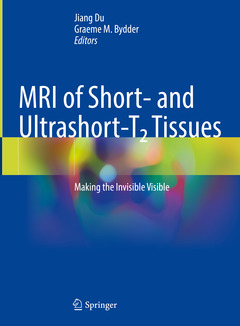MRI of Short- and Ultrashort-T2 Tissues, 2023 Making the Invisible Visible
Coordonnateurs : Du Jiang, Bydder Graeme M.

This is an ideal guide for physicists and radiologists interested in learning more about the use of UTE and ZTE type techniques for MRI of short and ultrashort-T2 tissues.
Dr Jiang Du is a physicist who is Professor of Radiology and Director of the Ultrashort Echo Time (UTE) Imaging Lab at the University of California, San Diego (UCSD). His research focuses on the development of magnetic resonance imaging (MRI), especially UTE MRI of short and ultrashort-T2 tissues such as cortical bone, tendons, ligaments, menisci, iron containing tissues and myelin. He has published over 200 papers and mentored more than 100 trainees. Currently,he is a principal investigator for three NIH RO1 grants and one VA merit grant to study osteoarthritis (OA), osteoporosis (OP), Alzheimer’s disease (AD), and traumatic brain injury (TBI). He has served on many academic organizations and review committees, including study sections for the National Institute of Health (NIH), Department of Defense (DOD), and Radiological Society of North America (RSNA). He has won numerous awards including the RSNA Research Scholarship, the American Heart Association (AHA) Young Investigator Award, the International Society of Magnetic Resonance in Medicine (ISMRM) Outstanding Teacher Award, the International Skeletal Society (ISS) Excellence Award, and the Academy for Radiology & Biomedical Imaging Research (ARBIR) Distinguished Investigator Award. Dr Du is Fellow of the ISMRM and American Institute for Medical and Biological Engineering (AIMBE).
Dr Graeme Bydder is a radiologist who began clinical MRI in 1981 and has continued to the present day. He was a joint author of the first paper on the use of MRI in multiple sclerosis in 1981 and the first comprehensive paper on MRI of the brain in 1982. He was also a joint author of many of the first papers describing techniques now commonly used in clinical imaging. These include: inversion recovery and heavily T2-weighted spin echo sequences, Gd based contrast agents, STIR, susceptibility weighted imaging and FLAIR. He has worked at UCSD since 2003 on UTE development which uses radial imaging and high performancDate de parution : 02-2024
Ouvrage de 611 p.
21x27.9 cm
Thème de MRI of Short- and Ultrashort-T2 Tissues :
Mots-clés :
MRI; UTE; Quantitative; contrast mechanism; short-T2 tissues



